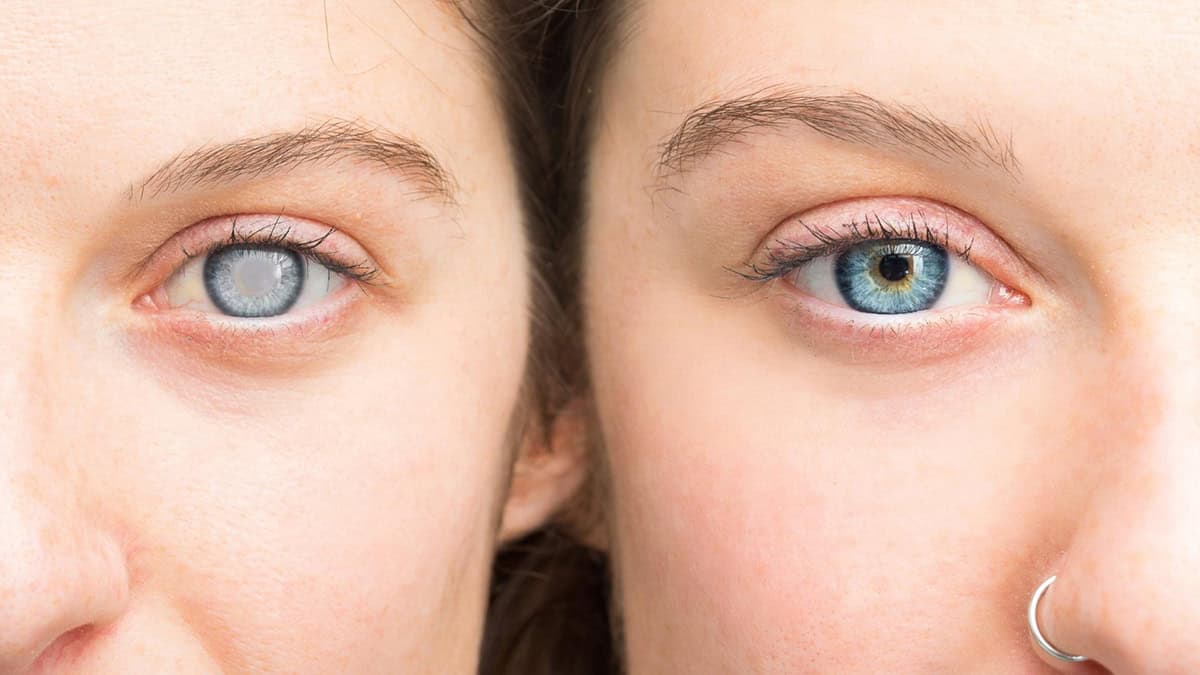All About Cataracts
Physical Health

All About Cataracts
Cataracts are a common eye condition in older adults that can result in vision loss. While brighter lights or a stronger eyeglass prescription may help cataract symptoms in the early stages, surgery is the only way to get rid of cataracts.
Continue reading to learn all about cataracts.
What Are Cataracts?
Cataracts refer to cloudy areas on the lens of your eye. When your lens becomes cloudy, it can make it more difficult to see.
To understand why cataracts make it more difficult to see, you should learn more about how your eye works. Different parts of your eyes help you convert light in your environment into images you can see.
In the first step of this process, light enters your eye through your cornea — the clear outer layer of your eye. Your cornea has a dome-like shape to help bend the light as it comes in so your eye can focus.
Next, light enters your pupil — the black opening in the middle of the colored part of your eye (called the iris). Your iris controls the amount of light your pupil takes in.
Your lens is the clear part of your inner eye that sits behind your pupil. After light enters your pupil, it passes through your lens. The lens helps to focus light onto your retina. If your lens is cloudy, light may not be directed to your retina the way it should be.
Your retina is a layer of tissue in the back of your eye with special cells (called photoreceptors) that translate the light you see into electrical signals. Your optic nerve carries the electrical signals from your retina to your brain, where the signals are converted into images.
What Causes Cataracts?
Cataracts are caused by proteins in the lens of your eye clumping together. This is a natural change that happens to many people after the age of 40.
When cataracts affect babies or children, it may be due to a genetic condition. Trauma to your eye can also cause cataracts to form.
Who Gets Cataracts?
Cataracts are a common condition. About 17% of people around the world have cataracts. Cataracts become more common as you age. Most cases of cataracts occur in adults over the age of 60. In the United States (US), almost 20% of people between the ages of 65 and 74 have cataracts. By age 80, more than half of people have developed cataracts.
You may have an increased risk of cataracts if you:
- Have diabetes
- Smoke cigarettes
- Drink too much alcohol (for example, 15 or more drinks per week for men or 8 or more drinks per week for women)
- Are related to someone with cataracts
- Have a history of eye injury
- Had eye surgery in the past
- Have had radiation treatment on your upper body
- Spend a lot of time in the sun
- Take a corticosteroid medication (a medication used to treat inflammation)
Some environmental risk factors may increase your risk of developing cataracts. An environmental risk factor is a toxic substance you may encounter in the world around you. These toxic substances can create free radicals in your body that damage healthy cells. If free radicals damage the lens of your eye, it could lead to cataracts. Examples of environmental risk factors include:
- Air pollution
- Cigarette smoke
- Chemicals used in industrial manufacturing
- Pesticides
- Ultraviolet (UV) light from the sun
What Are the Symptoms of Cataracts?

You may have cataracts for several years before you notice any symptoms.
If you have cataracts, you may notice changes in your vision, such as:
- Vision that’s cloudy, foggy, or blurry
- Colors don’t seem as vivid or appear faded
- Difficulty seeing at night
- Sensitivity to light
- Seeing a glare or halo around lights
- Double vision (also called diplopia)
- Needing more light to read
- Changes in your eyeglass or contact lens prescription (especially worsening near-sightedness)
Most people don’t experience any pain as a result of cataracts. However, sensitivity to light can cause discomfort in some people.
Your symptoms may differ based on the type of cataracts you have.
Types of Cataracts
There are different types of cataracts, including:
- Nuclear cataracts — These types of cataracts affect the center of your lens. You may notice that far-away objects appear blurry, but your vision is clear for objects close to you. Over time, you may have difficulty telling colors apart.
- Cortical cataracts — These types of cataracts affect the edge of the lens. You may notice white spots or streaks on the outer edge of your vision that spread to the center over time.
- Posterior subcapsular cataracts — These types of cataracts affect the back side of the lens. You may notice that it becomes more difficult to read or see halos around lights at night.
- Congenital cataracts — These types of cataracts are cataracts you’re born with. Congenital cataracts can be caused by genetics or other medical conditions. They don’t always affect your vision but will be removed if they do.
How Are Cataracts Diagnosed?
Cataracts are diagnosed by ophthalmologists or optometrists — healthcare providers who specialize in treating eye conditions.
It’s recommended that people over the age of 60 get an eye exam every 1 to 2 years.
Eye Exam
During an eye exam, your physician or optometrist will perform several tests to check the health of your eyes and look for cataracts, as discussed below.
Vision Test
During a vision test — also called a visual acuity test — your provider will use an eye chart to check how well you can see a series of letters that get smaller and smaller. Your provider will cover one eye so that you only test one eye at a time.
Visual Field Test
A visual field test will check your peripheral (side) vision. During this test, your provider will check how well you can see objects that are in the side of your vision without moving your eyes or your head. Your provider may also ask you to follow an object with only your eyes without moving your head. This test will give your provider information about the full range of your vision. Some providers use a computer program for this test.
Tonometry
A tonometry test measures the fluid pressure in your eye. Your provider will use a machine to blow a small amount of air onto your cornea. If you have increased pressure in your eyes, it could be a sign of a disease called glaucoma.
Dilated Eye Exam
During this exam, your provider will use special drops to dilate (widen) your pupil. When your pupils are dilated, your eye will let in more light. In this way, your provider can see more of your eye to check for problems.
While your pupils are dilated, your provider can use a special microscope called a slit lamp to examine the structure of your eyes up close.
While your pupils are dilated, your provider will also use a device called an ophthalmoscope to look at your lens and retina. This device helps check for signs of cataracts on your lens and any problems in your retina.
After your dilated eye exam, you may experience light sensitivity and blurry vision for a few hours. Since your vision will be blurry, it’s important that you don’t drive home after a dilated eye exam. Instead, you can ask a friend or family member to pick you up.
How Are Cataracts Treated?
Surgery is the only treatment that can cure cataracts. However, not everyone may wish to have surgery right away because cataracts don’t harm your eyes.
Other treatments can help you manage the symptoms of cataracts.
Lifestyle Changes
Changes in your daily habits may help you manage your cataract symptoms early on, including:
- Brighter lights
- Wear sunglasses with anti-glare treatment
- Use a magnifying glass or reading glasses
Glasses or Contacts
If you’re having problems with your vision caused by cataracts, you may need a new prescription for your eyeglasses or contacts. The right prescription can help you see better so you can get back to activities such as driving and reading.
Cataract Surgery

Surgery is the only treatment that can get rid of your cataracts. During surgery, your provider will remove your cloudy lens and replace it with an artificial lens — called an intraocular lens (IOL).
Because cataracts don’t harm your eyes, you may choose to wait for a time before having cataract surgery. Talk to your healthcare provider about whether cataract surgery is right for you.
Your provider may recommend cataract surgery in the following cases:
- Your cataracts affect your quality of life
- You have difficulty reading, driving, or watching television
- You have other medical conditions that affect your eyes, such as diabetic retinopathy or macular degeneration
When you and your provider decide it’s time to have cataract surgery, your provider will walk you through what you need to do before, during and after your surgery.
Before Surgery
You may need some preparation before cataract surgery. Your provider will give you specific instructions to follow.
You will need to visit your provider before surgery so they can choose the right IOL for you. To help with this process, your provider will measure the size and shape of your eye.
To help prevent an infection, your provider may ask you to start using special eye drops. Additionally, cleaning your eyelids and eyelashes the day before and the morning of surgery can help remove germs that may cause an infection.
In most cases, you won’t be able to eat or drink for several hours before surgery. You may need to temporarily stop taking some medications, such as those that cause bleeding. Talk to your provider for your exact instructions.
During Surgery
Cataract surgery is typically an outpatient surgery that takes about 1 hour. After surgery, most people can go home the same day. Most people will remain awake for the duration of surgery. However, numbing drops in your eyes help you from feeling any pain, and your provider can give you medication that will keep you relaxed during the surgery.
During the surgery, your provider will make a small cut in your eye to take out the cloudy lens. Then, they will insert the new lens in the same place as your natural lens.
After the surgery is complete, you will recover outside of the operating room before going home.
After Surgery
You may feel some discomfort for 1 or 2 days after surgery. You may also notice itching or sensitivity to light and touch. More serious symptoms could be a sign of a problem. Call your provider immediately if you notice the following symptoms after surgery:
- Vision loss
- Pain that doesn’t get better with medication
- Red eyes
- Flashes of light or dark spots in your vision
Your provider will give you instructions about how to protect your eyes after surgery. You may need to avoid certain activities, such as bending over or lifting heavy objects.
It usually takes about 8 weeks to completely heal from cataract surgery. During this time, you will visit with your provider to make sure you’re healing well.
Risks of Cataract Surgery
Cataract surgery is generally a safe procedure. However, there are potential risks, including:
- Infection
- Bleeding
- Swelling
- Vision loss
- Changes in your eye pressure
- Retinal detachment (when your retina is pulled out of place)
- Secondary cataracts (when your vision becomes cloudy again due to scar tissue formation)
Can You Prevent Cataracts?
While you may not be able to prevent cataracts, there are steps you can take, including:
- Get regular eye exams — getting regular eye exams can help you recognize any problems in the early stages
- Shield your eyes from the sun — wear a hat or sunglasses to block UV light
- Prevent eye injuries — protective eyewear can protect your eyes from accidental injury during certain activities, such as using power tools or playing some sports
- Don’t smoke — smoking is a risk factor for cataracts
- Drink alcohol in moderation — heavy alcohol use is a risk factor for cataracts
- Eat a healthy diet — a diet with plenty of fruits and vegetables will give you the vitamins and minerals you need to reduce your risk of cataracts
- Manage your health problems — health problems, such as diabetes, increase your risk of developing cataracts